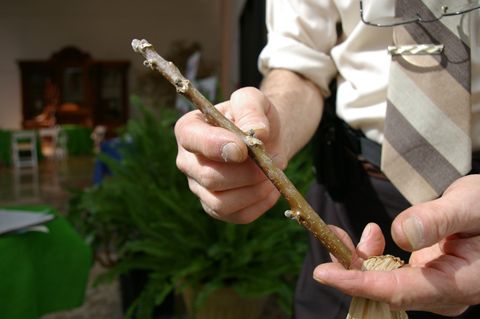
Last Sunday, Lissa Harris and Julia Reischel of the Watershed Post attended Farm to Market Connection, a networking conference for farmers and food buyers in Liberty, NY. It was a rare view of the local food economy: a community of farmers, foodmakers, distributors and retailers that is always thrumming with activity, but seldom gathers in one place. Here's our report.
The lobby was packed with farmers. Pork producers traded slick marketing brochures and swapped CSA-building tips. Lavender Tilsit from Harpersfield and ash-coated wedges of goat cheese from Cohoes were arrayed fetchingly on platters. An unassuming gentleman representing Northern nut growers stood behind a helpful plywood diptych, on which were pinned specimens of various underappreciated nuts. (Heart nut? Butternut? The relative ignominy of the latter may be attributed to the fact that cracking it requires a steampunk gadget the size of a fire extinguisher.)
But while the farmers were the stars of the show, the real evidence of a food revolution came from the buyers. Distributors, grocers, cheesemongers and greenmarketeers told of an insatiable hunger for food that is more than just a commodity.
Their message to farmers was loud and clear: We need more local food.
“There is so much agricultural production in upstate New York that isn't happening right now," said Gary Redmond, founder of the Ithaca-based food distribution network Regional Access. "There's land that could be productive.”
Twenty years ago, distributor Michael Kokas started Upstate Farms to sell the excess bounty from his wild-mushroom-picking jaunts to New York City chefs. Now he runs a year-round distribution network that ferries produce from dozens of farms to the New York restaurant market and carries hard-to-source items like local crème fraiche and wild-foraged nettles.
“Every time there's a food scandal or a food calamity, the local market gets stronger,” he said.
Most of that market, unsurprisingly, is New York City — the nerve center of the local-foods movement, and an insatiable consumer of food of all varieties. (One factoid that was bandied about: the vast majority of the country's prime beef cuts are destined for the New York market.) But retailers are having tremendous success selling local foods in rural areas as well.
“We have a golden, golden opportunity,” said Al Higley, Sr., who runs the Hanover Farms stand on Route 28 in Mount Tremper with his son, Al Higley, Jr.. “If you get it to us, we'll buy it. We'll sell it. If you have to get $7 or $8 a pound for cheese, we'll pay it.”
 Local bounty: Upstate New York cheeses on display at Farm to Market Connection. Photo by Julia Reischel.
Local bounty: Upstate New York cheeses on display at Farm to Market Connection. Photo by Julia Reischel.
John Buono, a manager at Foodtown, said that the grocery chain's efforts to showcase local produce in Margaretville, the small Delaware County village where their newest store is located, were being amply rewarded.
“We have the privilege of selling ramps and garlic from Pointer Farm in Margaretville,” he said. “We sold them like crazy. Couldn't get enough of them.”
Manhattan cheesemonger Anne Saxelby exhorted farmers that the stories behind their farms and their food is an integral part of the product.
“The more that we know about your farms, the more we can talk them up and get people interested,” she said.
Kokas agreed. “You might not think what you do is cool, but people really appreciate it. Especially if you're a second- or third-generation farmer," he said. “Young mothers are concerned about you, believe it or not."
Video of Bob Lewis from NYS Dept. of Agriculture and Markets speaking at the conference about local food demand:
Top photo: Nut grower with a black walnut graft. Photo by Julia Reischel.












